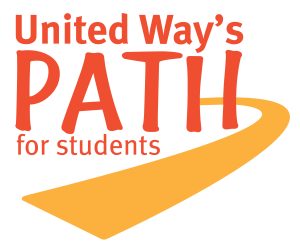
United Way’s PATH (Providing Access to Healing) for Students is a school-based program designed to improve access to mental health services for children and youth who are unable to obtain care elsewhere in the community.
PATH was created in 2008 by United Way’s Promoting Health, Healing and Crisis Intervention Impact Area in response to the growing need for mental health services. PATH was originally started as a pilot project in the Menasha Joint School District, offering services to elementary, middle, and high school students experiencing barriers to care.

In 2011, PATH was expanded in two phases over two years to nine other school districts. These include the Appleton, Freedom, Hortonville, Kaukauna, Kimberly, Little Chute, Neenah, Seymour, and Shiocton school districts.
The therapy is provided by Masters level, licensed therapists from Catalpa Health and Family Services of Northeast Wisconsin. All therapists have a minimum of three years of clinical experience and expertise in working with children and adolescents.
According to the 2006 LIFE Study, a community assessment of the Fox Cities, access to mental health services is a critical issue, particularly for area youth. In 2006, approximately 25% of 10th graders experienced depression in the past year and 14% had attempted suicide. More recent LIFE Study data is equally startling:
Since the program’s inception, PATH has served more than 2,000 students and reported the following results:
Many of the students are from families that are either uninsured or under-insured. Some of the students were on long waiting lists elsewhere in the community. One student had been on a waiting list for a year and a half. The students want to succeed in school and many of the high school students self-refer to the program.
The students experienced barriers to care elsewhere in the community such as: limited financial resources, parent work schedules, lack of reliable transportation, language barriers and lack of parental support.
Based on a cost benefit analysis conducted in the fall of 2012 by the Robert M. La Follette School of Public Affairs at the University of Wisconsin, Madison, for 155 students treated in a single school year the net benefits of PATH totaled $7,472,000 or approximately $49,000 per student. For students, the benefits include avoided medical costs, increased productivity and lifetime earnings, decreased risk of suicide, and increased quality of life. School districts experience decreased truancy and behavioral and counseling expenditures. For the community, there are avoided costs to the criminal justice system. The study was repeated in 2014 and showed similar results. For 183 students, the new benefit was $9,384,000.
For more information about PATH, please contact your child’s school or call one of the PATH providers:
Sign up for meaningful updates from United Way Fox Cities.
© 2025 United Way Fox Cities. All rights reserved.
Developed by Full Scope Creative

Please call 211 if you are looking for local resources. 24/7, a real person will answer your call.
If you are still considering a year-end gift, click the button below. Thank you for making our community brighter! 🌟